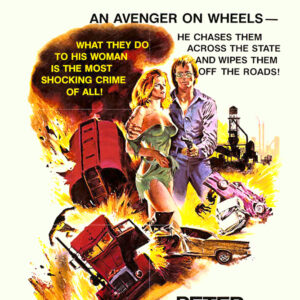calsfoundation@cals.org
Fighting Mad
B-movie mogul Roger Corman was responsible for three films made in Arkansas. After directing Bloody Mama (1970), he produced Boxcar Bertha (1972), which was directed by Martin Scorsese, and Fighting Mad (1976), which was written and directed by Jonathan Demme. After directing three movies for Corman, Demme went on to direct major films like Silence of the Lambs (1991) and Philadelphia (1993). In 1976, Peter Fonda, the star of Fighting Mad, was near the end of his brief period of stardom after his hit Easy Rider (1969). Supporting actor Scott Glenn was at the beginning of his starring career.
Corman once said that his films should have “a little violence but not too much; a little sex but not too much; a little politics but not too much.” Fighting Mad—with several killings, three nude scenes, and a businessman as lead villain—fits all those guidelines. In the commentary on the Shout! Factory DVD of the movie, Demme recalls that the film was made in imitation of such “redneck revenge” films as Walking Tall (1973) and Billy Jack (1971). The plot follows an Arkansas horse farmer (Fonda) who resists the efforts of a rapacious strip mining corporation to drive him off his land. After members of his family are killed, he takes bloody revenge. The local sheriff is of little use (and audiences must have suspected him to be corrupt and working for the villains), but in the end it turns out he is honest, though a stickler for evidence.
Fighting Mad was made mostly in rural areas of Washington County, with scenes also shot in Fayetteville (Washington County), Clarksville (Johnson County), and Fort Smith (Sebastian County). Local people played small parts, and Gino Franco, a local child, had a major role as the hero’s young son. In the DVD commentary, Corman and Demme note as major assets the film’s attractive locations; the cinematography by Michael Watkins (credited) and Tak Fujimoto (uncredited due to union rules); and the local color, including Ozarks music. The final shootout was staged in a house designed by Arkansas architect Fay Jones.
A Variety (April 28, 1976) reviewer wrote that the “totally predictable” film “doesn’t waste time on rounded characters or motivational development, but delivers its full quota of explosions, car chases, stabbings and other turn-ons for the vigilante mentality that seems to have appeal today.” The reviewer notes that “Demme has a good eye for visual detail” and concludes that the “best thing about the film is the moody lensing [photography] of Michael Watkins, which brings out the alluring qualities of the land.”
For additional information:
Bliss, Michael, and Christina Banks. What Goes Around Comes Around: The Films of Jonathan Demme. Carbondale, IL: Southern Illinois University Press, 1996.
Corman, Roger, with Jim Jerome. How I Made a Hundred Movies in Hollywood and Never Lost a Dime. New York: Random House, 1990.
Demme, Jonathan. Jonathan Demme: Interviews. Edited by Robert E. Kapsis. Jackson: University Press of Mississippi, 2009.
“Fighting Mad.” Internet Movie Database. http://www.imdb.com/title/tt0074529/?ref_=fn_al_tt_1 (accessed October 6, 2021).
Fighting Mad/Moving Violation [DVD]. Los Angeles, CA: Shout! Factory, 2011.
Fonda, Peter. Don’t Tell Dad: A Memoir. New York: Hyperion, 1998.
Michael Klossner
Little Rock, Arkansas
 Divergent Prosperity and the Arc of Reform, 1968–2022
Divergent Prosperity and the Arc of Reform, 1968–2022 Fighting Mad Poster
Fighting Mad Poster 




Comments
No comments on this entry yet.